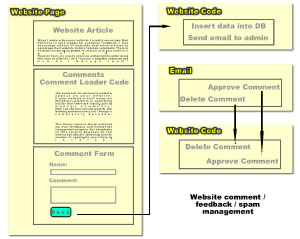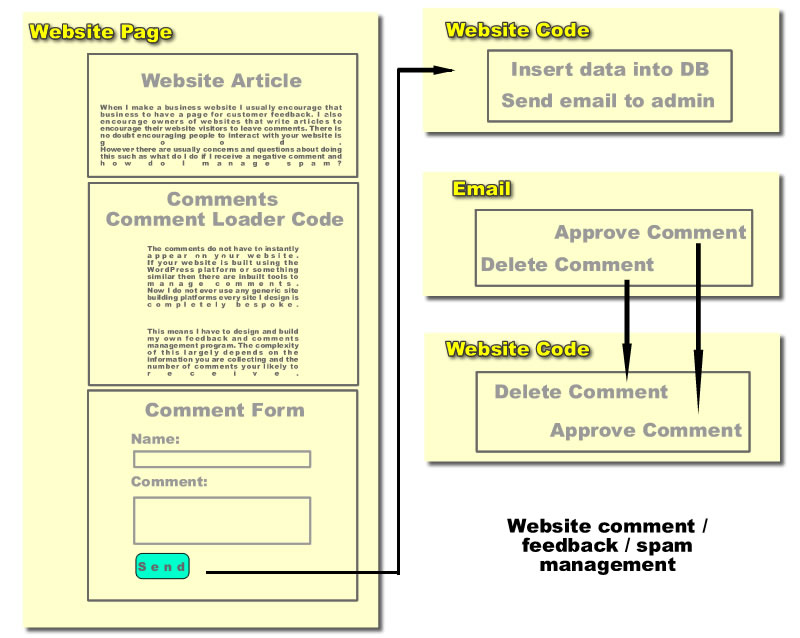 When I make a business website I usually encourage that business to have a page for customer feedback. I also encourage owners of websites that write articles to encourage their website visitors to leave comments. There is no doubt encouraging people to interact with your website is good. When I make a business website I usually encourage that business to have a page for customer feedback. I also encourage owners of websites that write articles to encourage their website visitors to leave comments. There is no doubt encouraging people to interact with your website is good.
However there are usually concerns and questions about doing this such as what do I do if I receive a negative comment and how do I manage spam?
The good news is both of these concerns can be easily managed.
The comments do not have to instantly appear on your website.
If your website is built using the Wordpress platform or something similar then there are inbuilt tools to manage comments.
Now I do not ever use any generic site building platforms every site I design is completely bespoke.
This means I have to design and build my own feedback and comments management program. The complexity of this largely depends on the information you are collecting and the number of comments your likely to receive.
For light feedback use you can simply have a website form that when submitted sends the information to you via email. You can then manually add this to your website if you chose.
A managed Option
For website articles where feedback is likely to be higher in volume and attract spam then a more sophisticated approach is required.
The process is simple but it does require a database to store the comments.
First you have a form on your website as before that site visitors can fill in and send.
Two things happen when the form is submitted. First the information is stored in your database and then an email notification is sent to you.
On receiving the email you can decide if to publish or delete the comment.
If you chose to publish it you can click a link in the email and it will be automatically published on your website in the correct place or on the appropriate page or article it relates to. If it is spam then you can click another link and it will be deleted from your database.
The last step in completing this semi automated article feedback management program is to have some code on the pages of your articles that loads the approved comments only that relate to that article.
This then allows you to quickly approve or disapprove comments and automatically add them to your website with one click thus saving you a lot of time and it also give you peace of mind and reassurance that nothing bad will ever appear on your website without you knowing.
The flow chart below illustrates the process.

What information should I collect and display and SPAM control
Email and Registration
Again this is primarily determined by the kind of website you have. Most user feedback forms demand that you sign up or register on a website prior to being able to leave a comment. With regards to small business websites then I really don’t feel this is necessary, even with larger websites this will often deter a visitor from having their say.
I have asked a number of website why this is a requirement and the most common answer is so that they can then contact you. Spam you more like!
Social Plug-ins
More commonly now, websites employ options for visitors to leave comments using a number of social network identities. This is actually quite useful and has a number of advantages. You don’t need to collect as much data about a user as this can be obtained automatically from their social profile and secondly it allows the person leaving the comment to be contacted via that social site.
The foremost advantage to the person leaving the comment is it makes the process far simpler than pre registering with a website and having to try to remember another password for a website that they probably won’t ever visit again!
Bare Minimum
If you do not employ a social plug-in then the bare minimum you need to ask for the name and the actual comment text. In addition you can collect the users email address so as you can notify them when their comment is approved and this will encourage them to return to your website to view their comment and any further feedback.
Some sites will automatically notify you when additional replies are received so users can keep track of that topic.
Additional Information URL’s and SPAM
In some cases it might be an advantage to ask for additional information such as the website address of the person leaving the comment. This will encourage people who have websites to leave comments as they can obtain both back-links and website traffic from their post. However spammers will abuse this and leave meaningless off topic comments and dubious links. Note they will leave links in the comments form so that is why you should employ some management for popular and busy websites.
It’s not always an easy task trying to determine what is a genuine comment or just spam. I wrote an article some time ago about recognising email spam and scams so perhaps I should do the same for comment spam.
Date and Security
It it’s perhaps useful to store a date when the feedback was left and the users IP address in case of severe abuse.
Even more, the data spies and the cookie monster
Most large organisations will collect lots of additional information about a website visitor even if you don’t leave comments, the pages you view, how long you looked at them, what web browser or device you are using as well as your location will all be logged.
The data can be used, allegedly, to increase customer experience, compile statistics about website visitors for marketing and track visitors to determine their browsing interests or habits.
This kind of spying involves the use of “cookies” which is regulated in the UK and websites that do this are obliged to notify the visitor that “cookies” have been installed and what data they are collecting.
If you see adverts for products on web pages that you have previously viewed or search for on other websites then you can be sure tracking cookies have been installed on your computer.
I hope you enjoyed this article and found it useful. Please leave your comments below. |